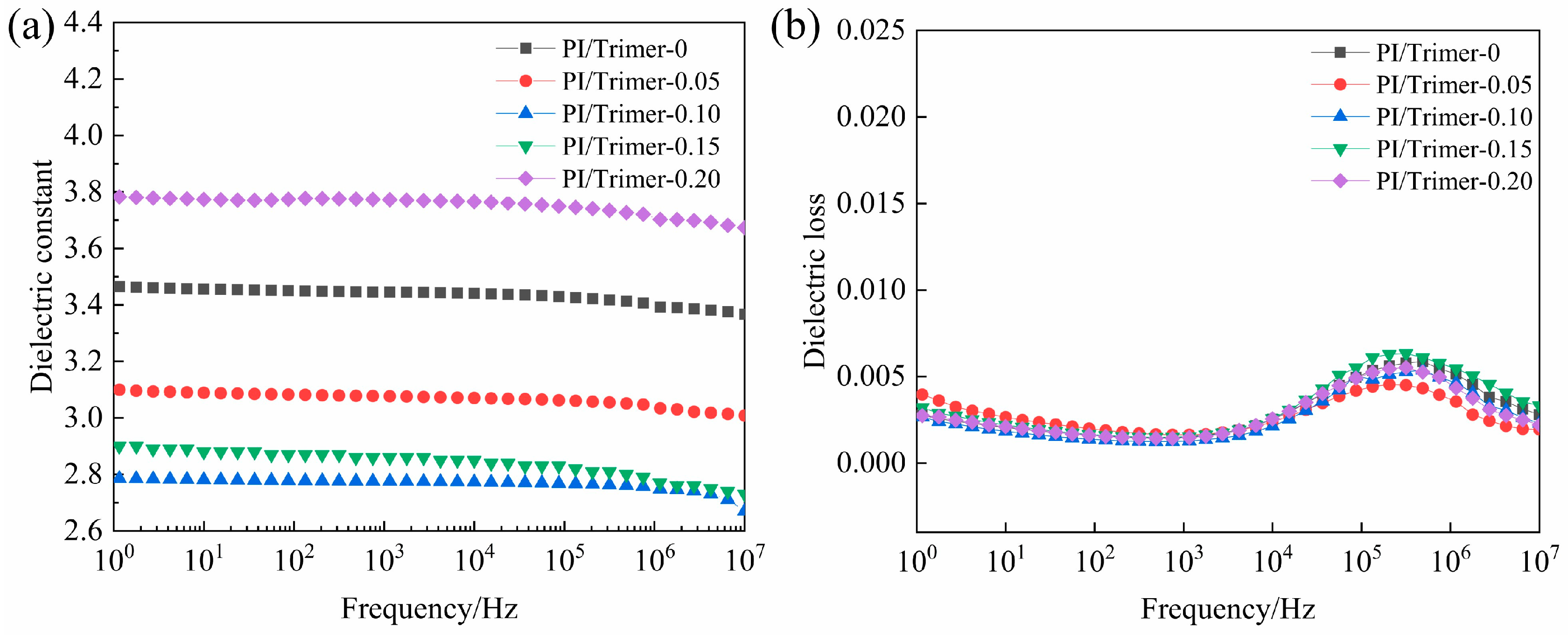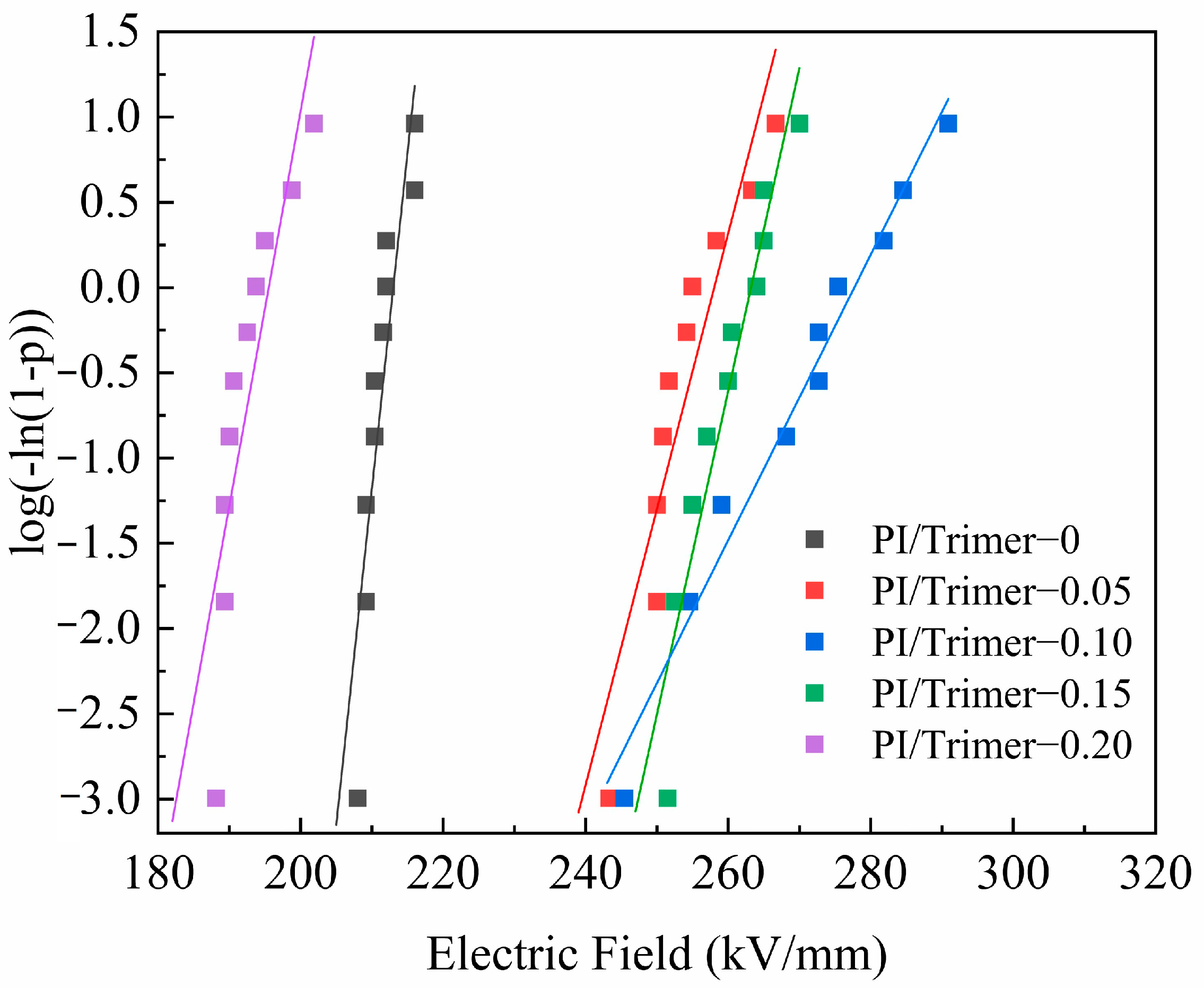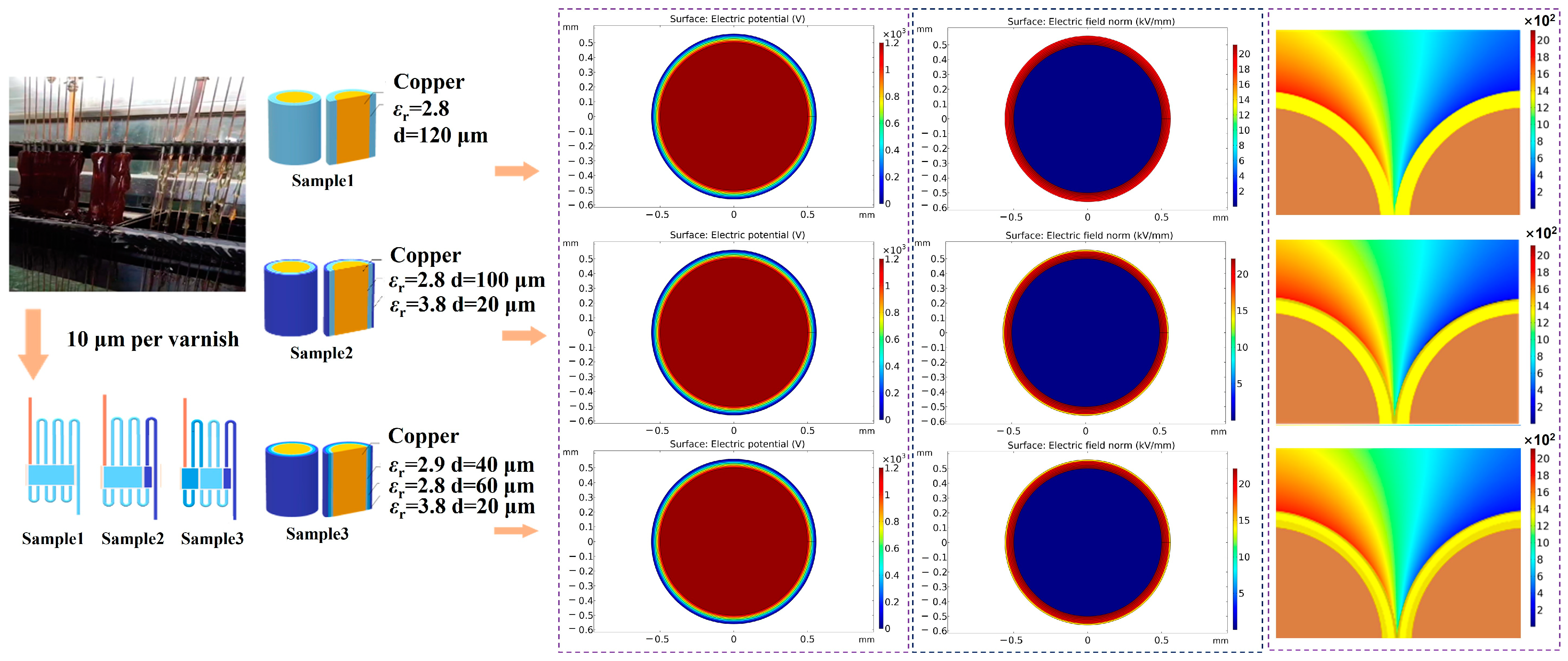Optimization of Insulation Structure Design for Enameled Wires Based on Molecular Structure Design
Abstract
1. Introduction
2. Materials and Methods
2.1. Materials
2.2. Preparation of BTDA/HDI/MDI/HDI Trimer–PI Films
2.3. Characterization
3. Results and Discussion
3.1. Segment Structure Characterization and Analysis
3.2. Dielectric Properties
3.3. Insulation Properties
3.4. Insulation Structure Design
3.5. Electric Field Simulation of the Insulation Structure
3.6. Realistic Enameled Wire Production Process and Design Model Realization Methods
4. Conclusions
Supplementary Materials
Author Contributions
Funding
Institutional Review Board Statement
Data Availability Statement
Conflicts of Interest
References
- Vershinin, A.V.; Dragomirov, M.S.; Zaitsev, A.M.; Kruglikov, O.V. Development of embodiments of variable-frequency induction motors. Russ. Electr. Eng. 2008, 79, 624–626. [Google Scholar] [CrossRef]
- Qin, Y.; Zhang, S.D.; Han, S.; Xu, T.T.; Liu, C.; Xi, M.; Yu, X.L.; Li, N.; Wang, Z.Y. Voltage-Stabilizer-Grafted SiO2 Increases the Breakdown Voltage of the Cycloaliphatic Epoxy Resin. ACS Omega 2021, 6, 15523–15531. [Google Scholar] [CrossRef]
- Vu, V.B.; Ramezani, A.; Triviño, A.; González-González, J.M.; Kadandani, N.B.; Dahidah, M.; Aguado, J. Operation of inductive charging systems under misalignment conditions: A review for electric vehicles. IEEE Trans. Transp. Electrif. 2022, 9, 1857–1887. [Google Scholar] [CrossRef]
- Yadav, K.S.; Sarathi, R. Influence of thermally aged barrier on corona discharge activity in transformer oil under AC voltages. IEEE Trans. Dielectr. Electr. Insul. 2015, 22, 2415–2423. [Google Scholar] [CrossRef]
- Janaj, A.; Bandi, A.; Desur, P.; Prabhu, D.; Datar, P.; Kulkarni, R.M. Improving electric field distribution on corona ring by nano-coating. AIP Conf. Proc. 2023, 2399, 020010. [Google Scholar] [CrossRef]
- Liu, X.; Liu, P.; Zhang, T.; Yuan, P.; Zhu, H. Detection method of inter-turn insulation defects of inverter-fed motors under induced impulse voltage. IEEE Electr. Insul. Mag. 2020, 37, 27–39. [Google Scholar] [CrossRef]
- Fallah-Arani, H.; Tehrani, F.S.; Koohani, H.; Elmdoust, B.; Nodoushan, N.J.; Shafiei, Z. Optimization of resin content to improve electrical and mechanical properties of polymer-concrete line-post insulators used in electrical distribution networks. Electr. Power Syst. Res. 2023, 220, 109357. [Google Scholar] [CrossRef]
- Zhang, C.; Liu, Z.; Tang, C.; Zhang, T.; Zhang, Y.; Zhang, Y.; Chi, Q. Study of the Dielectric and Corona Resistance Properties of PI Films Modified with Fluorene Moiety/Aluminum Sec-Butoxide. Polymers 2024, 16, 767. [Google Scholar] [CrossRef]
- Dong, Z.; He, Q.; Shen, D.; Gong, Z.; Zhang, D.; Zhang, W.; Jiang, Y. Microfabrication of functional polyimide films and microstructures for flexible MEMS applications. Microsyst. Nanoeng. 2023, 9, 31. [Google Scholar] [CrossRef]
- Bian, X.; Yu, D.; Meng, X.; MacAlpine, M.; Wang, L.; Guan, Z.; Yao, W.; Zhao, S. Corona-generated space charge effects on electric field distribution for an indoor corona cage and a monopolar test line. IEEE Trans. Dielectr. Electr. Insul. 2011, 18, 1767–1778. [Google Scholar] [CrossRef]
- Wang, Z.Y.; Sun, X.; Wang, Y.; Liu, J.D.; Zhang, C.; Zhao, Z.B.; Du, X.Y. Fabrication of high-performance thermally conductive and electrically insulating polymer composites with siloxane/multi-walled carbon nanotube core-shell hybrids at low filler content. Polymer 2022, 262, 125430. [Google Scholar] [CrossRef]
- Kwon, T.; Lee, S.H.; Kim, J.H.; Hong, S.K.; Kim, M.; Kim, M.; Kim, D.K.; Kim, I.J.; Song, J.; Lee, D.H.; et al. Polypropylene nanocomposites doped with carbon nanohorns for high-voltage power cable insulation applications. Adv. Compos. Hybrid Mater. 2023, 6, 167. [Google Scholar] [CrossRef]
- Huang, X.Y.; Thomas, A. Nanodielectrics. IEEE Trans. Dielectr. Electr. Insul. 2020, 27, 335. [Google Scholar] [CrossRef]
- Li, Z.; Okamoto, K.; Ohki, Y.; Tanaka, T. The role of nano and micro particles on partial discharge and breakdown strength in epoxy composites. IEEE Trans. Dielectr. Electr. Insul. 2011, 18, 675–681. [Google Scholar] [CrossRef]
- Zhou, H.; Lei, H.; Wang, J.; Qi, S.; Tian, G.; Wu, D. Breaking the mutual restraint between low permittivity and low thermal expansion in polyimide films via a branched crosslink structure. Polymer 2019, 162, 116–120. [Google Scholar] [CrossRef]
- Sun, Q.; Feng, Y.; Guo, J.; Wang, C. Achieving both low thermal expansion and low birefringence for polyimides by regulating chain structures. Eur. Polym. J. 2023, 189, 111986. [Google Scholar] [CrossRef]
- Liu, Y.; Zhang, Y.; Lan, Q.; Liu, S.; Qin, Z.; Chen, L.; Zhao, C.; Chi, Z.; Xu, J.; Economy, J. High-performance functional polyimides containing rigid nonplanar conjugated triphenylethylene moieties. Chem. Mater. 2012, 24, 1212–1222. [Google Scholar] [CrossRef]
- Chern, Y.T.; Tsai, J.Y. Low dielectric constant and high organosolubility of novel polyimide derived from unsymmetric 1, 4-bis (4-aminophenoxy)-2, 6-di-tert-butylbenzene. Macromolecules 2008, 41, 9556–9564. [Google Scholar] [CrossRef]
- Yamanaka, K.; Jikei, M.; Kakimoto, M.A. Preparation of hyperbranched aromatic polyimide without linear units by end-capping reaction. Macromolecules 2001, 34, 3910–3915. [Google Scholar] [CrossRef]
- Shiravand, F.; Ascione, L.; Persico, P.; Carfagna, C.; Brocks, T.; Cioffi, M.O.H.; Puglisi, C.; Samperi, F.; Ambrogi, V. A novel hybrid linear–hyperbranched poly (butylene adipate) copolymer as an epoxy resin modifier with toughening effect. Polym. Int. 2016, 65, 308–319. [Google Scholar] [CrossRef]
- Xu, P.; Du, X.; Cong, P.; Zhou, Z. Properties of paving epoxy asphalt with epoxy-terminated hyperbranched polyester. Road Mater. Pavement Des. 2022, 23, 234–246. [Google Scholar] [CrossRef]
- Yue, D.; Feng, Y.; Liu, X.X.; Yin, J.H.; Zhang, W.C.; Guo, H.; Su, B.; Lei, Q.Q. Prediction of energy storageperformance in polymer composites using high-throughput Stochastic breakdownsimulation and machine learning. Adv. Sci. 2022, 9, 2105773. [Google Scholar] [CrossRef]
- Li, Y.; Yin, J.; Feng, Y.; Li, J.; Zhao, H.; Zhu, C.; Yue, D.; Liu, Y.; Su, B.; Liu, X. Metal-organic Framework/Polyimidecomposite with enhanced breakdown strength for flexible capacitor. Chem. Eng. J. 2022, 42, 132228. [Google Scholar] [CrossRef]







| Sample | Density (g/cm3) | Specific Volume (Å) | Occupied Volume (Å) | FFV |
|---|---|---|---|---|
| PI/trimer-0 | 1.369 | 113,098.2 | 76,819.76 | 0.3207 |
| PI/trimer-0.05 | 1.356 | 65,111.07 | 43,787.38 | 0.3274 |
| PI/trimer-0.10 | 1.353 | 39,217.56 | 26,347.85 | 0.3282 |
| PI/trimer-0.15 | 1.347 | 27,893.85 | 18,649.97 | 0.3314 |
| PI/trimer-0.20 | 1.355 | 22,874.09 | 15,398.01 | 0.3268 |
| Sample | Control Group | Sample 1 | Sample 2 | Sample 3 |
|---|---|---|---|---|
| Maximum field strength | 10.60 kV/mm | 10.60 kV/mm | 11.05 kV/mm | 10.80 kV/mm |
| Outermost field strength | 9.45 kV/mm | 9.45 kV/mm | 7.27 kV/mm | 7.36 kV/mm |
| PDIV | 2213 V | 2491 V | 2435 V | 2410 V |
| BMMP | 212 kV/mm | 280 kV/mm | 280 kV/mm | 274 kV/mm |
| Margin multiplier | 20.00 | 27.18 | 25.33 | 25.37 |
Disclaimer/Publisher’s Note: The statements, opinions and data contained in all publications are solely those of the individual author(s) and contributor(s) and not of MDPI and/or the editor(s). MDPI and/or the editor(s) disclaim responsibility for any injury to people or property resulting from any ideas, methods, instructions or products referred to in the content. |
© 2025 by the authors. Licensee MDPI, Basel, Switzerland. This article is an open access article distributed under the terms and conditions of the Creative Commons Attribution (CC BY) license (https://creativecommons.org/licenses/by/4.0/).
Share and Cite
Yu, Y.; Li, S.; Weng, L.; Zhang, X.; Liu, L.; Chen, Q. Optimization of Insulation Structure Design for Enameled Wires Based on Molecular Structure Design. Polymers 2025, 17, 1002. https://doi.org/10.3390/polym17081002
Yu Y, Li S, Weng L, Zhang X, Liu L, Chen Q. Optimization of Insulation Structure Design for Enameled Wires Based on Molecular Structure Design. Polymers. 2025; 17(8):1002. https://doi.org/10.3390/polym17081002
Chicago/Turabian StyleYu, Yang, Siyuan Li, Ling Weng, Xiaorui Zhang, Laiweiqing Liu, and Qingguo Chen. 2025. "Optimization of Insulation Structure Design for Enameled Wires Based on Molecular Structure Design" Polymers 17, no. 8: 1002. https://doi.org/10.3390/polym17081002
APA StyleYu, Y., Li, S., Weng, L., Zhang, X., Liu, L., & Chen, Q. (2025). Optimization of Insulation Structure Design for Enameled Wires Based on Molecular Structure Design. Polymers, 17(8), 1002. https://doi.org/10.3390/polym17081002






